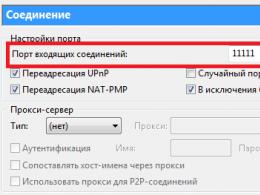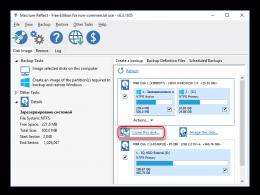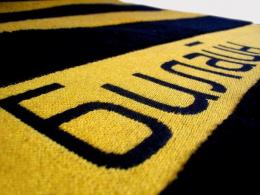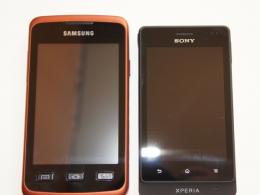Search by photo. How to find a similar picture, photograph, image on the Internet
I’ll tell you one way to deal with goons who don’t reveal secret places where they fish or pick mushrooms. I’ll say right away that there’s nothing smart about this method, but it works. I’m even sure that many people know about this, so today’s story will be for those who have never thought about it.
It’s simple, every person has a desire to brag, this is a fact (I can already “hear” a friend’s shout behind me, they say, Chernyakov, they don’t judge others by themselves). Almost all fishermen and mushroom pickers love to photograph their trophies and post their photos on the Internet. So, ask such a person to send you the original photo. For what? Well, you can lie, they say, I liked the photo so much that I want to set it as a screensaver on my Windows desktop.
It's simple. Almost everyone today takes photographs in nature with their mobile phones. Almost every cell phone has GPS. Almost every mobile phone has the option to put coordinates in a photo, and by default no one disables it. And if there are coordinates, then they can be seen. How? - easier than steamed turnips. Now I’ll show you using this photo as an example.
Digital photos have this thing called EXIF. I won't go into details now, I'll just say that it is additional information about the photograph recorded in the file of the photograph itself. There is a lot of interesting information there, for example: when the photo was taken, with what camera, and what is most interesting for us is where it was taken. Geographic coordinates are written there, and extremely accurate ones at that.
If the photo has already been downloaded to your computer, click on it right click mouse, then select “Properties” from the menu. In the window that opens, select the “Details” tab, and just below you will see the GPS coordinates. As I said, very accurate (and we will return to this picture again at the end of the article, remember it).

If you don't know what to do with these numbers, you can use, for example, Google's Picasa program. If the photo has coordinates, Picasa will show a red pin. Click on it and you will see a map.

As you understand, the Internet is already full of such services that show a map from a photograph. Just upload such a photo to the site or provide a link to it. I won’t even be lazy, I’ll explain how to “take a link to a photo.” For example, if you use Firefox, then everything is simple, right-click on the photo and click on “Copy Image Location”.

IN Internet Explorer a little more confused. Right-click on the photo, select “Properties”, in the window that opens, select the link with the mouse, right-click on the selected text and select “Copy”.


Here's the way. The main thing is to ask for a photograph.
And now information for new residents of Winnipeg who want to know exactly where mushrooms grow nearby. Over the weekend I was in a forest park. While riding a bicycle, I noticed an aspen boletus near the road. Since I didn’t intend to pick mushrooms, I just photographed the mushroom and moved on, without cutting it.
Here it is, a real untouched boletus, and if you need it, find the place yourself. By the way, not far from the city.

Okay, as you understand, “redneck” is true, it’s all nonsense. This is not the purpose of this article. I just want you to understand how terrible it is when technology falls into the hands of amateurs. And what a horror it is when criminals abuse the ignorance of amateurs. This is both a way to find where to steal something, and a way to find a person who is not guaranteed to be happy to meet you.
As far as I understand, when a photo is uploaded to Facebook or Odnoklassniki or (forgive me, gentlemen) on VKontakte, the system itself erases the coordinates for you. I also couldn’t get the coordinates from Instagram, but I read where it says that there is even an application for mobile phone, which from an Instagram photo shows a photo with Google Maps Street View, and address. But what about it?

I don’t know, I can’t check it myself. What do other Internet resources do with photographs? – we also just have to guess. But you understand that it is better not to guess, but to trust in your own head.
Now the obvious conclusions. Yes, we know that mobile phones enter by default GPS coordinates into a photograph. And it's wonderful, yes! Especially when you bring a bunch of photos from a long trip, and then you don’t remember where it all was. And then one day, they found it.
But this is great for personal use. If you want to take a photo from your phone and send it to someone, but don’t want them to see the coordinates, every smartphone has an option in the settings not to include GPS coordinates in the photo file. Turn it off and take pictures. If you need to, turn it back on. Business?
If the photo is on a computer, it’s even easier. Before sending a photo, make a copy of it, and then, as I said above, right-click on the photo, then select “Properties” from the menu. In the window that opens, select the “Details” tab, and at the very bottom click on “Remove Properties and Personal Information”.
By the way, on my website, when I publish photos, I almost never erase the coordinates. Firstly, nothing personal, and secondly, perhaps you yourself are interested in knowing where the places that I photographed are located. And once, yes, I was greedy, but this is the same “secret” clearing.
In general, let's summarize. If we already use technology, we use it consciously so as not to be a monkey with a grenade. And there are plenty of all sorts of tricky technologies. For example, as I noticed, a huge number of owners of Android phones do not even suspect the existence of such a useful (and dangerous) site https://maps.google.com/locationhistory/ And this is not the limit.
HashPhotos is a small utility that makes dull geotags dance to our tune. Its task is to show where this or that photo from your photo feed was taken.
HashPhotos is a small utility that makes dull geotags dance to our tune. Its task is to show where this or that photo from your photo feed was taken. And believe me, there are more benefits from this function than it seems at first glance.
Imagine that you arrived in an unfamiliar city and checked into a hotel. To find it in the evening, you need to find out the address, write it down somewhere in your iPhone, or add a bookmark to Maps. The same should be done with the train station, museums, the nearest metro station, etc.
 Open the photo you want and swipe up to see the exact location on the map
Open the photo you want and swipe up to see the exact location on the map HashPhotos greatly simplifies this routine. You simply take a photo of the object you want (hotel, cafe) with a standard camera and continue your walk. If you need to remember where a certain place is, just select the corresponding photo in HashPhotos, and you will immediately see it on the map along with the date and exact coordinates.
With a couple of clicks, the whole thing can be “sent” to regular cards to create a route, or copy the coordinates to the clipboard.
 Press the "share" key to open the shooting coordinates in Google Maps and get directions to them
Press the "share" key to open the shooting coordinates in Google Maps and get directions to them Let's start with the fact that until recently, search engines could not effectively search the Internet for images that interest you. The entire search process took place only according to the words that we entered in the search. It was very difficult! After all, the desired image directly depended on its description, which could appear in the text next to the image on various sites, as well as on the name of the picture.
For example:
You are looking for paintings by the famous artist Pablo Picasso. Yes, the search engine will find his paintings for you, but next to them he could find an image that a child drew, and his parent jokingly signed it: “Pablo Picasso’s greatest work!”
Of course, maybe you are a professional and can easily distinguish the original from a child’s painting, but not everyone can do it.
But we are still growing and developing, and the same can be said about search engines. Today there are only a few services that you can give preference to. The top three are naturally Yandex and Google, and in third place is the lesser-known TinEye. By the way, Bing and Rambler still search for pictures by words. Let's start the review.

Here Google offers additional search criteria by size, similar images, and sites where your searched image may be located.

Search by image in I'm index
![]() Method No. 1
Method No. 1
To search by image in Yandex, follow the link yandex.ru/images or go to home page Yandex and click on “Pictures”. Then click on the camera icon.

Like Google, there are three options for uploading an image for search:
- Enter the address of the image, that is, the URL.
- Upload a file from your computer.
- Drag the image directly into the search area.
Method number 2
This method is convenient for those who use the default Yandex browser. As with Google, just right-click on the image you want, then “Find this image in Yandex”.

Result
This is what Yandex gave us after searching for a photo:

Yandex, unlike Google, does not try to guess what exactly is shown in the photo; instead, it offers a convenient table with all possible sizes.

Search by photo in TinEye
And finally, the third image search service that tops our list is TinEye. To start your search, simply go to tineye.com and upload or drag the image you want into the search area.
For the test, we chose a photo, deliberately removing any mention of Jaguar from the title. As you can see in the screenshot below, TinEye did an excellent job. Found 61 results and even indicated correct name car.

Which service to choose for image search?
The conclusion can be summed up very simply. During the experiment, we tested more than one image in various services. In our opinion, these three coped more than well and it seems to us that it is best to use Google or Yandex, since the last application is on English language. If with language barrier no, then you can safely use the one you like best. It's also worth noting that the above services are of course not perfect, so if you're looking for something specific, you can test all three. But remember that if they didn’t cope with your task, then no one else can cope. Next, we’ll look at how to search by image from your phone.
Search by image from your phone (Android, iPhone).
To find a photo, picture or any other image from your phone, you don’t need to make any effort. Everything is exactly as easy and simple as on regular computer. The search can be carried out using a picture that you have on your smartphone or one that you found on the Internet.
So, let's say you are interested in the photo of the girl shown below and you would like. To do this, of course, you need to send it to one of the search engines. Google systems or Yandex.

Tap and hold on the photo until a pop-up menu appears.

Click on “Find this image on Google” and you will instantly be taken to a page with the results of what the search engine found. In the Yandex browser you can do exactly the same manipulation. If your picture or photo is on your smartphone, then to search you need to follow the same steps as on your computer (see the beginning of the article).
Search by image using mobile applications.
– 1 –
Google Lens(Google Lens)(Android)(iOS)
Great app that works like artificial intelligence and can use your camera to determine what's in your lens. That is, in real time you can find out about almost everything, wherever you are. For example, while shopping, when choosing an item, use the Google Lens application and it will immediately display all similar or the same items in different stores, where you can choose an affordable price for yourself. If you don’t know the breed of the dog, please open Google Lens and find out the breed, etc.

Also, this application very conveniently scans various types of text, links, etc. This means that if, while at your desktop computer, you need to send a link to someone in messenger, then just point your smartphone’s camera at the desired link, click on it and you can immediately copy it , send or simply go to it from your phone.

This application helps you find some products in stores. Let's say you like something, you can immediately take a photo this item, thing, etc. and the app will help you find a place to buy it.

Browser extensions for searching pictures, photos and images.
Sometimes you may encounter a situation that you need to find an exact image and would like to check in all services at once. Of course, it won’t take 2 hours, but you’ll still have to tinker. A service can help you with this, or rather a browser extension – PhotoTracker Lite. Works with browsers: Yandex, Chrome, Opera. There is another bonus: the application searches for images in the Bing search engine.This way, you can use all four services at the same time to find the image you need. To get started, install the extension in your browser.
After installation, you will be able to configure the extension, which services to search in, as well as in which window to open the results page (background or active, to do this, click on the “settings” gear).
![]()
After setting up the extension, you can safely use it for its intended purpose. By right-clicking, as in Google and Yandex, you can see a new subsection “Search this image”. Click and the extension will redirect you to the results.
![]()
But that's not all, PhotoTracker Lite has another nice search feature. This is the “Quick Search Icon”, where all results will be loaded even faster (on and off in the extension settings).
![]()
After clicking on the search, you will see results in all selected (depending on settings) services.
It is worth noting that this extension copes with its task very well and can be very useful for those who are involved in photography, have a direct connection with working with images, etc.
Watch a video on how to use the PhotoTracker Lite extension:
Despite all the shortcomings that can happen when using these services and applications, they are still the best that exist today.
Any modern digital camera records in a photo file Additional information about the photo - EXIF data: model of the camera with which the photo was taken, shutter speed, aperture, focal length, ISO sensitivity, time and date of shooting, etc.
When you upload a photo to Yandex.Photos, this information is saved. To open it, on the photo viewing page, click the More icon and select Show EXIF.
Why don't some photos have EXIF?
If a photo is taken with a film camera and then scanned, it cannot have EXIF data because it is assigned to the photo when the file is created digital camera.
Graphic editor(For example, Adobe Photoshop, Lightroom) may remove EXIF data with certain file saving settings.
Also, some mobile phones do not leave EXIF data.
How can I find out the model of the camera that took the photo and see other photos taken with this camera?
On the photo viewing page, tap the More icon.
Select Show EXIF.

You will be taken to a page with photographs of other authors whose works were taken by this camera model and posted on Yandex.Photos.
How to find out where a photo was taken?
Each photo on Yandex.Photos can be linked to a map. If the photo is already linked to a map, to find out its location, click the On map link, which is located on the photo viewing page.

If the photo is not linked to the map, but you know where it was taken, you can offer the author of the photo your option for placement on the map. To do this, click the link Link to map under the photo.
You will be taken to a map page where you can enter the location of the photo. If the author agrees with your proposal, you will receive a message by mail.
Searching for photos from your phone is not as difficult a task as it might seem. To reveal all the aspects of this process, we will try to outline what to do if you have the original image on your smartphone and if you want to find something related to the image found on the Internet.
In the second option, there are not so many solutions to the problem, but as long as we have our beloved Google, there is nothing to be afraid of.
As easy as pie
So you are interested in a photograph in some article and want to know more about it. If you haven't yet turned to your favorite browser and use the one built into Facebook, Twitter or something else, now is the time to turn to Chrome, Firefox, Dolphin or any other option that suits you. Having opened the link in the browser, you select the image you are interested in with a long tap and open it in a new tab (in the appeared context menu This option will appear, here we see the option to quickly save the image or immediately start searching for it using Google)
When you see just one image on the page, all you have to do is copy the link to it and consider that half the work is already done.
Opening new tab and go to home page Google. Here we are interested in the “Pictures” section. Once you go to it, all you have to do is paste the previously copied link to the image into the search bar. Click “Search” and enjoy the results. As a rule, among the really useful information unnecessary appears. You can refine your search using special filters, but mobile version website, they are not available, so click the “menu” button and put a tick next to the line “ full version" Here you can set all the parameters you are interested in: size, type, time, etc.
An equally interesting option is to select an image close to the one you are interested in and follow the “similar” link.



Now let’s consider a situation in which the picture is saved on your smartphone (by the way, you can also save it from the browser if fiddling with copying links seems difficult to you)
We go back to the Google start page and the “Images” tab, but now we select the “Upload File” tab. When you click on it, you will have access to your gallery. Having selected the desired photo, repeat the steps from the previous paragraphs and again you will surely find the one you need.



Applications to help
Now let's look at other ways to search for information using photos from a smartphone. We don't need a browser for this, but we will need third party applications, which will have to be installed in advance.
Google Googles(Android) is perhaps the most famous application of this kind. It hasn't received updates for a long time, but it's still working. Managing it is extremely simple: launch the camera in the application, point it at the object of interest, and take a photo. In a few seconds, you will already have all the available information on the object of interest. Admittedly, this method works best with known objects: trademarks, attractions, art objects, etc. Here you can read barcodes and translate text, even solve Sudoku.





CamFind(Android, iOS) - works approximately the same, but is designed mainly for searching for all kinds of products, and can even help you find online stores where they are sold. But it also easily finds related and simply similar images, saves the search results that interest you to your favorites and allows you to quickly share them. There is a code scanner, recognition of famous places and even voice control. You can search from the gallery and from the camera.




Specialized services
But that is not all. If you don’t have time to install third-party applications, and fiddling with tabs in the browser is tiring, you can turn to the corresponding service, the sole purpose of which is to search for images. Tineye was and remains the best in its class. Here you can also upload an existing image or insert a link to it into the search bar (read above for how to get the link you are interested in). The service finds copies of the image you uploaded and links to the resources where they appeared. Alas, everything works only if it is 100% similar. The service also has one more interesting feature- working with flowers. That is, you can upload an image that Tineye will analyze, select key colors in it and find you pictures in the same color palette or, conversely, will select images based on specified colors.




So, these are the three simplest and universal methods to search for any images and information on the Internet when you only have one picture on hand. And if not all, then at least one of them will definitely lead you to success.






